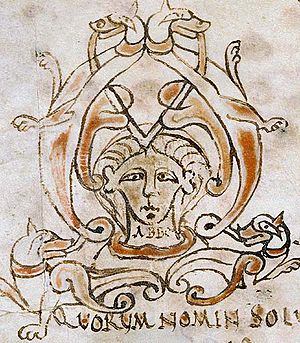Abbo of Fleury facts for kids
Quick facts for kids SaintAbbo of Fleury |
|
|---|---|

Title page from a tract written by Abbo of Fleury, showing the word "ABBO", created between 962 and 986 in Fleury Abbey
|
|
| Born | c. 945 Orléans |
| Died | 13 November 1004 (aged 58–59) The monastery of La Reole in Gascony |
| Venerated in | Catholic Church Eastern Orthodox Church |
| Feast | 13 November |
Abbo or Abbon of Fleury (Latin: Abbo Floriacensis; circa 945 – 13 November 1004) was an important monk and abbot. He led the Fleury Abbey in what is now Saint-Benoît-sur-Loire, France. People also know him as Saint Abbo. He was a respected scholar and a key figure in his time.
Contents
The Life of Abbo of Fleury
Early Life and Education
Abbo was born around the year 945 near Orléans, France. He grew up in the Fleury Abbey, a Benedictine monastery. He received a great education in Paris and Reims. Abbo studied many subjects, including philosophy, mathematics, and astronomy.
Time in England
From 985 to 987, Abbo spent two years in England. He mostly stayed at the new Ramsey Abbey in Huntingdonshire. There, he helped Archbishop Oswald of York improve the monastic system. He also served as the abbot and director of the school at Ramsey Abbey.
Becoming an Abbot
Abbo returned to Fleury in 988. After the death of Abbot Oilbold, Abbo was chosen to be the new abbot. Another monk challenged this choice. This disagreement became a big issue for the whole country.
Gerbert of Aurillac, who later became Pope Sylvester II, helped settle the matter. He decided that Abbo should be the abbot. Abbo then became involved in the politics of his time.
Political Involvement
For example, Abbo attended a meeting called the Synod of Verzy. This meeting was near Reims. At the synod, Arnulf, Archbishop of Reims was accused of treason (betraying his king). He was removed from his position, and Gerbert took his place. Abbo also had disagreements with Arnulf of Orléans about how monasteries should be run. This lasted from 988 to 994.
Important Journeys and Influence
In 996, King Robert II (also known as Robert the Pious) sent Abbo to Rome. The King wanted to prevent the Pope from issuing an interdict. An interdict is a church punishment that stops religious services in a certain area. This was because of King Robert's marriage to Bertha.
On his way to Rome, Abbo met Pope Gregory V. The Pope was hiding because an Antipope John XVI had forced him out of the city. Abbo and Pope Gregory V had great respect for each other. However, the Pope did not approve King Robert's marriage.
Abbo also helped bring Arnulf back as the Archbishop of Reims. He played a big role in calming people's fears. Many people in Europe were worried about the end of the world as the year 1000 approached.
His Final Days
In 1004, Abbo tried to improve discipline at the monastery of La Réole in Gascony. He moved some monks from Fleury to this monastery. But this caused more problems. Fighting broke out between the two groups of monks.
When Abbo tried to stop the fight, he was hurt by a lance (a type of spear). He hid his wound and made it back to his room. He died there in the arms of his loyal student, Aimoin. Aimoin wrote about Abbo's work and good deeds.
Miracles were said to happen at Abbo's tomb. Because of this, the Church in Gaul (an old name for France) began to see him as a saint and martyr. A martyr is someone who dies for their beliefs. Even though Rome did not officially make him a saint, his feast day is celebrated on November 13.
Abbo's Writings and Legacy
Important Works
While in England, Abbo learned about the death of Edmund of East Anglia. Edmund was killed in November 870. Abbo wrote a special story in Latin about Edmund's life and death. This type of story is called a "passion."
He also wrote a Latin grammar book for his English students. He wrote three poems for Dunstan, an important English archbishop. Abbo also simplified the computus. This was a way to calculate the date of Easter.
Other works by Abbo include:
- An Epitome de XCI Romanorum Pontificum Vitis: This was a shorter version of an older book about the lives of Roman popes.
- A Collectio Canonum: This book explained topics in Canon Law, which are the rules of the Church.
- Other writings about debated topics and letters.
Around 980 to 985, Abbo wrote a detailed explanation of the "Calculus" by Victorius of Aquitaine. This was before Arabic numbers were used, so calculations were very complex. Abbo's explanation showed his wide knowledge. He wrote about wisdom, the meaning of numbers, and how one thing can be made of many parts. He also used his knowledge of grammar, logic, and how the universe works to explain his ideas. He connected all of this to his beliefs about God's creation. Most of Abbo's writings can be found in the Patrologia Latina, a collection of Christian writings.
His Biographer and Impact
There is one biography of Abbo written by his student, Aimoin. This book includes many of Abbo's letters. It is very important because it tells us a lot about the rule of Robert II of France. It also gives information about the Papacy (the office of the Pope) during that time.
Richard W. Pfaff, a historian, summarized Abbo's achievements. He said Abbo was one of the most talented thinkers and writers of his time. Abbo influenced many areas of medieval life and thought. He was especially important for sharing valuable ideas from French monasteries with the new monasteries in England in the late 900s.
See also
 In Spanish: Abón de Fleury para niños
In Spanish: Abón de Fleury para niños

